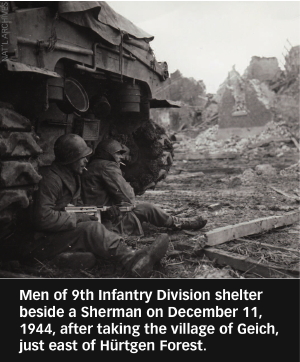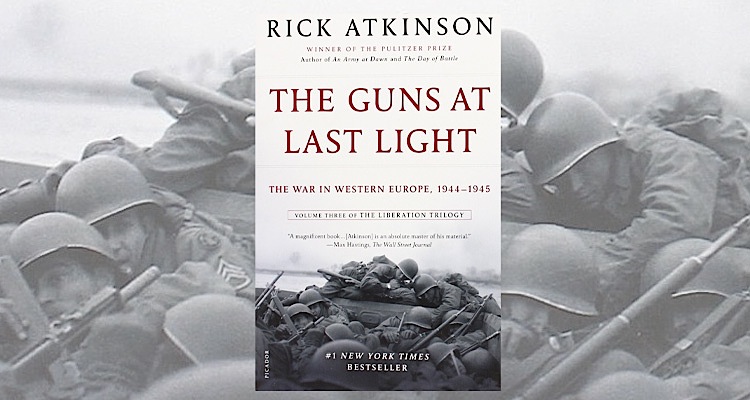 THE GUNS AT LAST LIGHT
THE GUNS AT LAST LIGHT
The War in Western Europe, 1944–1945
By Rick Atkinson. 896 pp.
Henry Holt and Co., 2013. $40.
For almost 15 years—three times longer than World War II lasted—Pulitzer winner Rick Atkinson has toiled with Herculean devotion to trace the American journey through hell to moral and military victory in Europe: from North Africa up the jagged and murderous spine of Italy, and now at last from Normandy to the gates of Dachau.
Has it all been worth it? The question inevitably arises when assessing yet another sweeping account of Europe’s liberation: what can be added to the canon that has not been covered before by so many so well? In short, a great deal. To use that well-worn but apt cliché, it all depends on how you tell it. Indeed, this final installment of Atkinson’s exhaustive Liberation Trilogy is unlikely to win the Pulitzer for originality. But it will gain Atkinson his largest readership yet. Unlike other heavyweight authors who penned doorstopper tomes in recent years, Atkinson does not resort to contrarian posturing, blatant regurgitation, or queasy mythmaking. Instead, with lyrical élan, he accurately and objectively tells the greatest story of our time, and does so with the general reader always in mind.
While the pacing is a little too slow at the outset, once the Allies land in France the narrative moves into high gear and rarely falls back. It pulls us across Hell’s Beach where young Americans were “butchered like a bunch of hogs,” as one dispatch put it on June 6, 1944, through the Norman hedgerows, to sunlit avenues during the liberation of Paris on August 25, 1944—“one of the greatest days of all time,” in the words of Ernie Pyle, whose muscular and elegant prose Atkinson’s best writing often evokes. The stalling of the Allies in fall 1944 along Germany’s borders, the British debacle at Arnhem, the immense courage and suffering of GIs throughout but particularly at the Battle of the Bulge, the egomania of the Allied generals, the infighting that seemed only to grow more rancorous the closer the Allies got to Berlin—Atkinson covers all of it with both judicious broad strokes and vivid detail.
There is much to savor that hasn’t received full due from others attempting to tell all in one volume: the heady march north from the Cote D’Azur after Dragoon, the war’s most successful amphibious invasion, the unforgivable slaughter in Hürtgen Forest, where so very many died for no good reason, and the bitter winter fighting in the Vosges. These episodes contain little glory but more than enough tragedy, and now have their proper place in the greater story of the American odyssey in Europe. Particularly effective are Atkinson’s crisp portraits of the Allied generals. There is no cheap sniping at Montgomery, no over-inflation of Eisenhower’s skills. Both legends are fully realized humans—flawed but still possessed of awe-inspiring devotion to duty. “If I could get home,” a chain-smoking Ike wrote his mother in July 1944, “I could lie down on the front lawn and stay there for a week without moving.” Patton too leaps from these pages as a charismatic enigma. America’s last great cavalryman, he was crucially also the hard-driving maniac even democracies need to win wars. “Hang up and keep going,” bellowed Old Blood-and-Guts to a subordinate who called to report his position.
Finally, gloriously, the Rhine was crossed, the unimaginable camps liberated, and Germany’s surrender accepted as spring flowers bloomed amid the ruins where more people had died more quickly than ever in history, including 135,576 Americans. For the 361,000 wounded GIs who returned home, forever changed, there were further struggles. But there was also profound consolation for more than a few. The war had been the most meaningful accomplishment of their lives—“the one great lyric passage,” as one officer called it. The same could be said of Atkinson’s richly rewarding and beautifully crafted book.
Alex Kershaw has been a journalist for 25 years, and is the bestselling author of several books about World War II, including
The Bedford Boys (2004) and The Liberator (2012). The National WWII Museum, for which Kershaw leads the annual Victory in Europe travel tour, opened an exhibit in January 2013 on the USS Tang, which Kershaw first wrote about in his 2008 book, Escape from the Deep.





